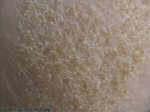Find Out How To Keep
Foot Eczema On It's Toes, And Off Of Yours
For the sufferer, foot eczema can be painful and a big source of discomfort.
The main types of eczema that can affect your feet are

Symptoms
Eczema on your feet tends to occur predominately between the toes, the heel, and the ball part of the foot. Though it can appear on any part.
The main symptoms of foot eczema are
When the skin becomes cracked and dry, an infection can occur. The symptoms will become worse. The skin will become more inflamed, wet, and be harder to clear and manage.
The symptoms can look a lot like Athletes Foot. Athletes foot is red and itchy. It is common between the toes. The symptoms are the only similarity between them. Athletes foot is contagious. It is caused by a fungal infection that loves warm, moist places to grow.
The treatment is completely different too. This is why it is very important to get the right diagnosis. If you try to treat whichever condition you have yourself it could be made worse.
You can read more about athletes foot, here
Causes
Your foot eczema can be triggered by, and made worse, by
- Sweat. Sweat makes the skin wet, which can irritate your eczema. If you wear tight fitting shoes or woollen socks you are likely to sweat more
- Allergic reaction. Something in your shoes or socks could cause a reaction. They can be made with materials and dyes that can irritate your skin
- Skin rubbing against shoes and socks. This is especially a problem if your eczema is already inflamed, sore and itchy
Treatment
If mild, treating your foot eczema can be relatively easy.
It is important to keep your skin moisturised. So the best way to manage your eczema is to use an emollient. It helps to keep the skin supple. This prevents your skin breaking, so reducing the chance of an infection occurring.
You can also use a topical steroid. They help to reduce inflammation, so reducing itching.
If an infection does occur then you may be prescribed either topical or oral antibiotics. They will kill the bacteria causing the infection. Using alongside an emollient and/or a topical steroid can help to clear a flare up.
Using any creams or ointments on your feet can pose a few issues. Because we can be on our feet for a great deal of time we need to set some time aside to apply the creams. This is to allow time for the cream to absorb into the skin.
If you are limited on time, you could wrap a bandage around the affected area, after the cream has been applied. This can stop the cream rubbing off on your shoes or socks.
If your foot eczema is severe, then your doctor may recommend you try light therapy. Though not all doctors will suggest it.
As well as using conventional treatment, there are also some things you can do yourself.
Managing Your Foot Eczema
There are some easy things you can do to prevent your eczema from flaring up
- Keep your feet dry. Wearing shoes all day can make your feet sweat. When you get home after work, take your shoes, tights and socks off. Then clean your feet. Pat them dry with a soft towel, and apply your favourite emollient. Try and go bare foot as often as you can
- Soak your feet. This can help in relieving itching. Mix some emollient into a bowl of warm water. Soak your feet for no longer than 15-20 minutes. Gently pat them dry, and apply moisturiser
- Use an occlusive dressing. These are especially useful at night, when most people find their eczema itchier. Apply your eczema cream to your feet. Wrap your feet in bandages. This will help with the absorption of the cream, and also makes it a lot harder for you to scratch!
- Wear 100% cotton socks. Your feet can breathe easier in them
- Find some good shoes. Leather shoes and trainers can make the feet sweat and trigger an outbreak. A lot of shoes also contain dyes that may cause an irritation. Wearing flip flops can also be an issue if the eczema is between your toes. Canvas shoes and open shoes are a good choice, but not always practical. That is when other precautions should be taken if more practical and irritating shoes have to be worn
- Rotate your shoes. Try not to wear the same pair of shoes every day. Alternate them. This gives them time to dry out, before you wear them again
If you have a good self management plan, and look after your skin well, then your foot eczema shouldn’t cause you too much discomfort. But we all know that sometimes eczema just seems to flare up for no reason that we can see. If your eczema is causing you a lot of pain or isn’t clearing, visit your doctor or dermatologist.
Return from Foot Eczema to Eczema On Body
Return from Foot Eczema to What is Eczema
Search What Is Eczema?
Advertising on What Is Eczema?
We are a participant in the Amazon Services LLC Associates Program, an affiliate program which allows sites to earn fees by advertising and linking to amazon.com. If you make a purchase through a link on this page, I may receive a small commission, at no extra cost to you. Many thanks
